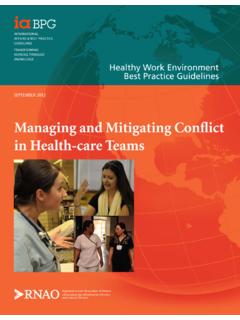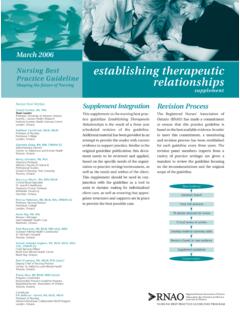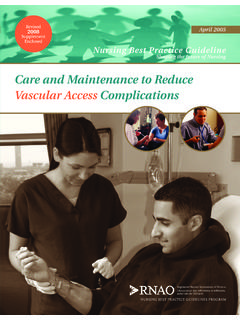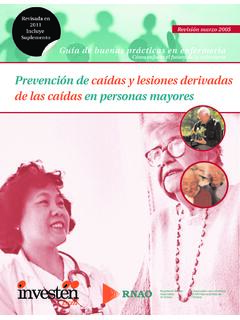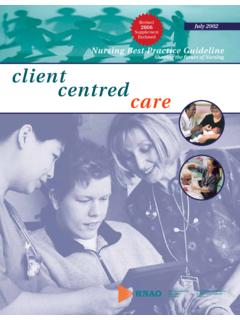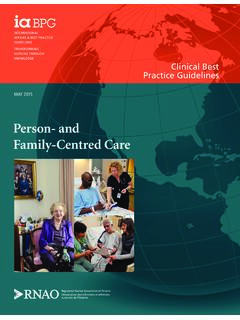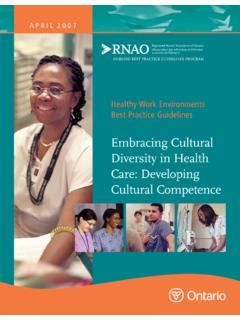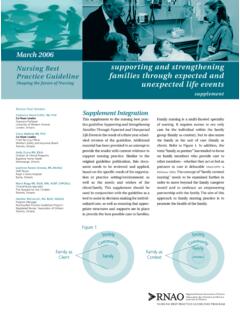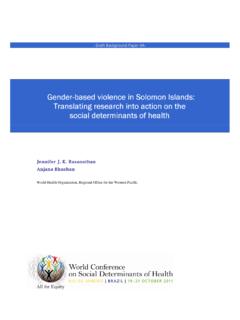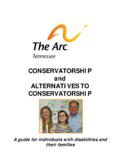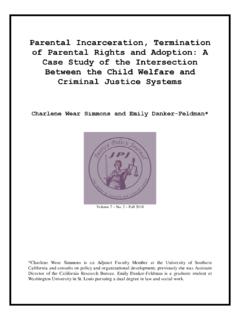Transcription of Promoting Safety: Alternative Approaches to the …
1 BEST PRACTICE GUIDELINES 1 FEBRUARY 2012 Promoting safety : Alternative Approaches to the Use of RestraintsClinical BestPractice Guidelines REGISTERED NURSES ASSOCIATION OF ONTARIOP romoting safety : Alternative Approaches to the Use of RestraintsDisclaimerThese guidelines are not binding on nurses or the organizations that employ them. The use of these guidelines should be flexible, and based on individual needs and local circumstances. They neither constitute a liability nor discharge from liability. While every effort has been made to ensure the accuracy of the contents at the time of publication, neither the authors nor the Registered Nurses Association of Ontario give any guarantee as to the accuracy of the information contained in them nor accept any liability, with respect to loss, damage, injury or expense arising from any such errors or omissions in the contents of this work.
2 CopyrightWith the exception of those portions of this document for which a specific prohibition or limitation against copying appears, the balance of this document may be produced, reproduced and published in its entirety, without modification, in any form, including in electronic form, for educational or non-commercial purposes. Should any adaptation of the material be required for any reason, written permission must be obtained from the Registered Nurses Association of Ontario. Appropriate credit or citation must appear on all copied materials as follows: Registered Nurses Association of Ontario. (2012). Promoting safety : Alternative Approaches to the Use of Restraints.
3 Toronto, ON: Registered Nurses Association of Program is funded by the Ontario Ministry of Health and Long-Term InformationRegistered Nurses Association of Ontario158 Pearl Street, Toronto, Ontario M5H 1L3 Website: BEST PRACTICE GUIDELINES 1 Greetings from Doris Grinspun,Executive Director Registered Nurses Association of OntarioIt is with great excitement that the Registered Nurses Association of Ontario (RNAO) presents this guideline, Promoting safety : Alternative Approaches to the Use of Restraints, to the health-care community. Evidence-based practice supports the excellence in service that nurses are committed to delivering in our day-to-day practice.
4 The RNAO is delighted to provide this key resource to you. The RNAO offers its heartfelt thanks to the many individuals and institutions who are making our vision for Nursing Best Practice Guidelines (BPGs) a reality: the government of Ontario for recognizing our ability to lead the program, and providing multi-year funding; Irmajean Bajnok, Director, RNAO Interna-tional Affairs and Best Practice Guidelines (IABPG) Program, for her expertise and leadership in advancing the production of the BPGs; each and every Team Leader involved, and for this BPG in particular Laura Wagner and Athina Perivolaris for their superb stewardship, commitment and expertise.
5 Also thanks to Brenda Dusek, RNAO s IABPG Program Manager, for her intense work to see that this BPG moved from concept to reality. Special thanks to the BPG Panel we respect and value your expertise and volunteer work. To all, we could not have done this without you!The nursing community, with its commitment to and passion for excellence in nursing care, has provided the knowl-edge and countless hours essential to the development, implementation, evaluation and revision of each guideline. Employers have responded enthusiastically by nominating best practice champions, implementing and evaluating the guidelines and working towards a culture of evidence-based practice.
6 Successful uptake of these guidelines requires a concerted effort from nurse clinicians and their health-care colleagues from other disciplines, and from nurse educators in academic and practice settings and from employers. After lodging these guidelines into their minds and hearts, knowledgeable and skillful nurses and nursing students need healthy and supportive work environments to help bring these guidelines to practice actions. We ask that you share this guideline with members of your interprofessional team, as there is much to learn from one another. Together, we can ensure that the public receives the best possible care each and every time they come in contact with us.
7 Let s make them the real winners in this important effort!Doris Grinspun, RN, MSN, PhD, LLD(Hon), DirectorRegistered Nurses Association of OntarioPromoting safety : Alternative Approaches to the Use of RestraintsPromoting safety : Alternative Approaches to the Use of Restraints2 REGISTERED NURSES ASSOCIATION OF ONTARIOHow to use this Document ..4 Summary of Recommendations ..5-7 Interpretation of Evidence ..8 Development Panel Members ..9-10 Stakeholder Acknowledgements ..11-16 Purpose and Scope ..17 Responsibility for Development ..18 Background Context ..19-21 Practice Recommendations ..22-43 Education Recommendations ..44-45 Organization and Policy Recommendations.
8 46-50 Research Gaps and Future Implications ..51 Evaluation/Monitoring of Guideline ..52-55 Implementation Strategies ..56 Process for Updating and Reviewing Guideline ..57 References List ..58-67 Bibliography ..68-82 Appendix A: Glossary of Terms ..83-87 Appendix B: Guideline Development Process ..88 Appendix C: Process for Systematic Review ..89-92 Table of ContentsBACKGROUNDRECOMMENDATIONSREFEREN CESAPPENDICESP romoting safety : Alternative Approaches to the Use of Restraints BEST PRACTICE GUIDELINES 3 Appendix D: Description of the Toolkit ..93 Appendix E: Example: Experience of Being Restrained (SEBR) Interview Tool ..94-96 Appendix F: Example: Short-Term Assessment of Risk and Treatability Tool (START).
9 97-98 Appendix G: Example: Broset Violence Checklist Tool ..99-100 Appendix H: Example: Historical-Clinical-Risk Management: 20 (HCR-20) ..101 Appendix I: Example: Coping Agreement Questionnaire (CAQ) ..102-103 Appendix J: Example: Alternative Approaches List ..104-107 Appendix K: Example: Caregivers Perceptions of Restraint Use Questionnaire (PRUQ) ..108-112 Appendix L: Example: ABC (Antecedent-Behavior-Consequence) Charting Template ..113 Appendix M: Example: Behaviour Monitoring Log ..114-115 Appendix N: Example: Alternative to Restraints Decision Tree ..116 Appendix O: Example: Mutual Action Plan Behaviour Profile ..117-118 Appendix P: Example: safety Plan Interventions.
10 119-120 Appendix Q: Example: Siderail and Alternative Equipment Intervention Decision Tree ..121 Appendix R: Example: Personal De-escalation Plan ..122-123 Appendix S: Example: safety Plan Women s Program ..124 Appendix T: Example: Comfort Plan Mental Health and Addiction Program ..125 Appendix U: Example: De-escalation Tips and Interventions to Assist Patients Cope ..126-127 Appendix V: Resource List of Websites ..128-130 Appendix W : Example: Observation & Documentation Record: 12-Hour Emergency Use of Chemical Restraint, Seclusion & Mechanical Restraint Record ..131-138 Appendix X: Example: Debriefing Form: Patient Debriefing Tool following Restraint/Seclusion ..139 Appendix Y: Example: Organization Audit Form: Least Restraint Last Resort (LRLR) Program: Unit-based Data Collection Form for the Least Restraint Last Resort (LRLR) Program Adherence.
